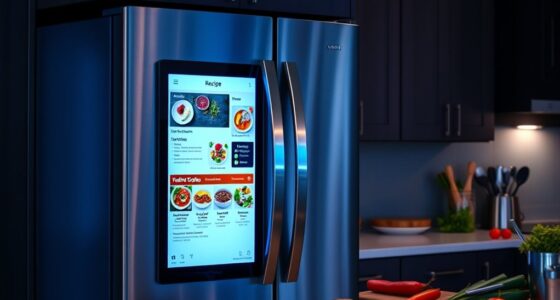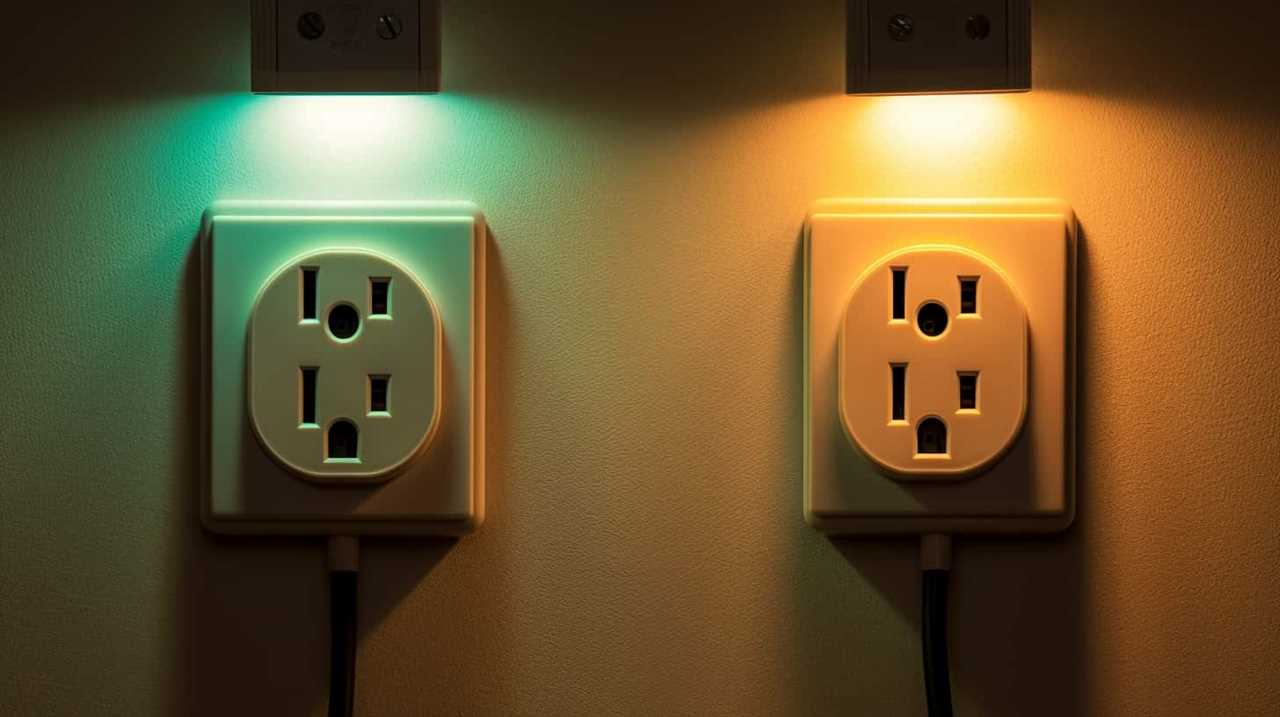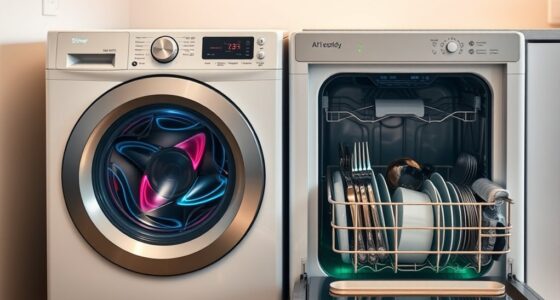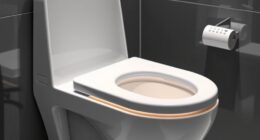When it comes to turning your home into a smart sanctuary, the options are limitless. But where should you start on this thrilling adventure?
We’ve compiled a comprehensive list of the best starter smart home appliances, designed to elevate your living experience to new heights of convenience and efficiency. From smart thermostats that optimize energy usage to voice-controlled speakers that bring your favorite tunes to life, these devices are essential for the modern homeowner seeking mastery over their surroundings.
With security cameras, smart door locks, and lighting systems, you can ensure the safety and comfort of your space. And with smart home hubs, security systems, blinds, curtains, and garage door openers, you’ll be well on your way to a fully automated and integrated home.
Let’s explore the possibilities together!

Key Takeaways
- Smart thermostats and voice-controlled speakers are essential starter smart home appliances that enhance comfort, convenience, and energy efficiency.
- Integration between voice-controlled speakers and other smart devices creates a connected and automated home environment.
- Security cameras with high-resolution video quality and wide-angle lenses provide a sense of protection and advanced technology.
- Smart door locks and smart lighting systems offer enhanced security, convenience, customization, and remote access.
Smart Thermostats
We highly recommend installing smart thermostats as the first step in creating a smart home. Smart thermostats are an essential component of any modern home automation system, offering a range of features that enhance comfort, convenience, and energy efficiency.
These devices utilize voice recognition technology, allowing you to control your thermostat with simple voice commands. By integrating with popular virtual assistants like Amazon Alexa or Google Assistant, you can effortlessly adjust the temperature in your home without lifting a finger.
One of the key advantages of smart thermostats is their energy-saving capabilities. With advanced sensors and algorithms, these devices can learn your daily routines and adjust the temperature accordingly, ensuring that you’re always comfortable while minimizing energy waste. Additionally, many smart thermostats provide detailed energy usage reports, allowing you to monitor and optimize your energy consumption.
Furthermore, smart thermostats often integrate with other smart home devices, such as smart lighting or security systems, creating a seamless and interconnected home automation ecosystem. This integration enables you to create custom scenes or routines, where multiple devices work together to enhance your home’s functionality and efficiency.

Voice-Controlled Speakers
Voice-controlled speakers have become increasingly popular among smart home enthusiasts. These devices offer seamless integration with other smart devices, allowing users to control various aspects of their home with just their voice.
Additionally, the setup process for voice-controlled speakers is typically straightforward and user-friendly, making them an excellent choice for those new to smart home technology.
Popular Voice-Controlled Speakers
After researching various options, it is clear that voice-controlled speakers are one of the most popular smart home appliances for beginners. These speakers, equipped with voice recognition technology, allow users to control various aspects of their smart home just by speaking commands. The benefits of voice control are numerous. It provides a hands-free and convenient way to interact with your smart home devices, making tasks such as adjusting the thermostat, playing music, or even ordering groceries as simple as saying a few words. Additionally, voice-controlled speakers often have built-in virtual assistants, such as Amazon Alexa or Google Assistant, which can provide useful information, set reminders, and answer questions. To help you choose the right voice-controlled speaker for your needs, here is a comparison table of some popular options:
| Speaker | Virtual Assistant | Price | Features |
|---|---|---|---|
| Amazon Echo | Alexa | $99.99 | Music streaming, smart home control, skills |
| Google Home | Google Assistant | $129 | Voice search, smart home control, Chromecast |
| Apple HomePod | Siri | $299 | High-quality audio, smart home control |
Remember to consider factors such as compatibility with your existing smart home devices and the ecosystem you are already invested in.

Integration With Smart Devices
As we delve into the topic of integration with smart devices, it becomes evident that voice-controlled speakers offer seamless connectivity to various smart home appliances. With these speakers, you can effortlessly control and monitor your voice controlled coffee machines, allowing you to start brewing your favorite cup of joe without even leaving your bed.
Additionally, these speakers can also be used to control and adjust various smart bathroom fixtures, such as smart showers and smart mirrors, making your morning routine even more convenient.
The integration between voice-controlled speakers and smart devices creates a truly connected and automated home environment.
Now that we understand the benefits of integrating smart devices with voice-controlled speakers, let’s move on to the next section and explore the ease of setup for these smart home appliances.

Ease of Setup
To set up voice-controlled speakers for your smart home appliances, we found that connecting them to your existing Wi-Fi network is a simple and straightforward process. Smart home automation relies heavily on Wi-Fi connectivity, allowing you to control your devices through voice commands.
When setting up your voice-controlled speakers, ensure that your Wi-Fi network has a strong and stable connection. Start by plugging in the speaker and downloading the corresponding app. Open the app and follow the instructions to connect the speaker to your Wi-Fi network. You may need to enter your Wi-Fi network name and password.
Once connected, the speaker will be ready to sync with your other smart devices and respond to your voice commands. With a smooth setup process, integrating voice-controlled speakers into your smart home automation system becomes effortless.
Security Cameras
When looking for security cameras for your smart home, there are a few key features to consider.

Firstly, you’ll want to ensure that the cameras have high-resolution video quality and wide-angle lenses for maximum coverage.
Additionally, it’s important to choose cameras that offer budget-friendly options without compromising on functionality.
Lastly, integration with other devices, such as your smartphone or voice-controlled speakers, can enhance the overall security system of your home.
Features to Consider
We prioritize the following features when considering security cameras for a starter smart home:

- Resolution: A high-resolution camera ensures clear and detailed footage, allowing you to easily identify people or objects.
- Field of View: A wide field of view enables you to monitor a larger area, reducing the number of cameras needed.
- Night Vision: Cameras with infrared or low-light capabilities provide clear images even in complete darkness, ensuring 24/7 surveillance.
- Two-Way Audio: This feature allows you to communicate with people near the camera, making it useful for monitoring visitors or deterring intruders.
When selecting security cameras for your smart home, it’s important to prioritize ease of use and energy efficiency. Look for cameras that offer simple installation and intuitive controls, ensuring a hassle-free experience. Additionally, consider cameras with energy-saving features like motion detection or power-saving modes to optimize efficiency and reduce energy consumption.
Budget-Friendly Options
For budget-friendly options, our top picks for security cameras offer reliable performance without breaking the bank. When it comes to affordable smart home devices, you don’t have to compromise on quality or security. These budget-friendly security cameras provide an excellent solution for those looking to enhance their home security without spending a fortune.
With features like high-definition video quality, motion detection, and night vision, these cameras ensure that you can keep an eye on your property at all times. Additionally, many of these cameras offer easy installation and compatibility with mobile apps, allowing you to monitor your home from anywhere.
In the next section, we’ll explore how these budget-friendly security cameras seamlessly integrate with other smart devices in your home.

Integration With Other Devices
To seamlessly integrate these budget-friendly security cameras with other devices in our smart home, we can explore their compatibility and connectivity options. Here are four ways these cameras can be integrated into our existing smart home ecosystem:
- Integration with smart home hubs: These security cameras can be connected to popular smart home hubs like Amazon Echo or Google Home, allowing us to control them through voice commands or smartphone apps.
- Integration with smart speakers: With the help of voice assistants like Alexa or Google Assistant, we can use our security cameras to view live feeds or receive alerts on our smart speakers.
- Integration with smart bathroom fixtures: Some security cameras can be integrated with smart bathroom fixtures, allowing us to view the camera feed on smart mirrors or bathroom TVs.
- Integration with wearable smart devices: By connecting our security cameras with wearable smart devices, we can receive notifications or view camera feeds on our smartwatches or fitness trackers.
Smart Door Locks
One of the essential smart home appliances to consider adding to your collection is a smart door lock. Smart door locks provide a convenient and secure way to control access to your home. With features such as keyless entry, remote unlocking, and integration with other devices like smart doorbell cameras, smart door locks offer a range of benefits.
Here is a table that highlights some of the advantages of smart door locks:
| Benefits of Smart Door Locks |
|---|
| Enhanced security |
| Convenience |
| Remote access |
| Integration with smart devices |
| Keyless entry |
Smart door locks offer enhanced security by allowing you to monitor and control access to your home from anywhere. With keyless entry, you no longer have to worry about losing your keys or hiding spare keys outside. Instead, you can easily unlock your door using a smartphone app or a passcode.

In addition to security, smart door locks provide convenience. You can grant temporary access to guests or service providers remotely, without having to be physically present. Integration with smart devices like smart doorbell cameras allows you to see and communicate with visitors before granting access.
As we transition to the next section on smart lighting systems, it’s important to note that smart door locks are an essential component of a comprehensive smart home setup. They provide security, convenience, and seamless integration with other devices, making them a valuable addition to any smart home.
Smart Lighting Systems
When it comes to smart home automation, smart lighting systems offer a range of benefits.
Not only can they enhance the ambiance of your home, but they also provide convenience and energy efficiency.

With smart lighting systems, you can control your lights remotely and schedule them to turn on and off automatically.
Plus, most smart lighting systems are compatible with popular platforms like Amazon Alexa and Google Assistant, making it easier to integrate them into your existing smart home setup.
Benefits of Smart Lighting
We love the convenience and energy-saving benefits of smart lighting systems. Here are four reasons why you should consider incorporating smart lighting into your home:
- Voice controlled assistants: With smart lighting, you can control your lights using voice commands through voice controlled assistants like Amazon Alexa or Google Assistant. This allows for a hands-free and seamless experience.
- Energy efficiency: Smart lighting systems are designed to be energy efficient. They use LED bulbs, which are more energy efficient and have a longer lifespan compared to traditional incandescent bulbs. Additionally, smart lighting systems allow you to schedule and automate the lighting in your home, ensuring that lights are only on when needed.
- Customization and flexibility: Smart lighting systems offer a wide range of customization options. You can adjust the brightness and color of your lights to create the perfect ambiance for any occasion. You can also create schedules and scenes to automate your lighting based on your preferences.
- Remote access: With smart lighting, you can control your lights from anywhere using your smartphone or tablet. This means that even if you’re not at home, you can still turn your lights on or off, giving you peace of mind and added security.
Compatible With Platforms
Smart lighting systems that are compatible with popular platforms offer seamless integration and enhanced functionality for a truly connected smart home experience. These systems can be easily controlled through smart home hubs, allowing users to manage their lighting settings from a single interface. Additionally, they can be synchronized with other smart home devices, such as smart home security systems, to create a comprehensive and automated home security solution.

To better illustrate the compatibility of smart lighting systems with different platforms, consider the following table:
| Platform | Compatible Smart Lighting Systems |
|---|---|
| Amazon Alexa | Philips Hue, LIFX, TP-Link Kasa |
| Google Assistant | Philips Hue, LIFX, Nanoleaf |
| Apple HomeKit | Philips Hue, LIFX, Nanoleaf |
| Samsung SmartThings | Philips Hue, Sengled, Osram Lightify |
Smart Plugs and Outlets
Our top pick for starter smart home appliances is the smart plug. Smart plugs and outlets are essential devices that allow you to control and automate your electronics and appliances remotely.
Here are four reasons why smart plugs and outlets are beneficial for your smart home setup:
- Versatility: Smart plugs are compact and can fit into any standard electrical outlet, instantly transforming it into a smart outlet. This versatility allows you to control a wide range of devices, from lamps and fans to TVs and coffee makers.
- Convenience: With smart plugs and outlets, you can easily turn your devices on or off using your smartphone or voice commands. You can schedule specific times for your appliances to turn on or off, creating a more efficient and convenient home environment.
- Energy savings: Smart plugs and outlets provide energy monitoring features that let you track and manage your energy usage. By identifying energy-hungry devices and setting timers or schedules, you can reduce your energy consumption and save money on your utility bills.
- Integration with other smart devices: Smart plugs and outlets often integrate seamlessly with other smart home devices and platforms. This allows you to create comprehensive automation routines, where your smart plugs and outlets work in harmony with your smart lights, thermostats, and security systems.
Smart Kitchen Appliances
When it comes to building a smart home, one area to consider is incorporating smart kitchen appliances. These appliances not only make our lives more convenient but also enhance our cooking experience. Two key smart kitchen appliances to consider are the smart fridge and the smart coffee maker.

A smart fridge is a game-changer in the kitchen. It is equipped with features like built-in Wi-Fi, touchscreens, and cameras that allow you to see what’s inside your fridge from your smartphone. You can create shopping lists, set expiration date reminders, and even order groceries directly from your fridge. With its advanced temperature control and energy-saving capabilities, a smart fridge not only keeps your food fresh but also reduces your energy consumption.
Another essential smart kitchen appliance is the smart coffee maker. Imagine waking up to the aroma of freshly brewed coffee, without even having to get out of bed. With a smart coffee maker, you can schedule brewing times from your smartphone and have a hot cup of coffee waiting for you when you wake up. You can also adjust the strength of your coffee and receive notifications when your coffee is ready to be enjoyed.
In summary, incorporating smart kitchen appliances like a smart fridge and a smart coffee maker can greatly enhance your kitchen experience. They offer convenience, efficiency, and the ability to control your appliances remotely. So why not upgrade your kitchen and make it smarter? Check out the table below for a quick comparison of these two smart kitchen appliances.
| Smart Fridge | Smart Coffee Maker |
|---|---|
| Built-in Wi-Fi | Schedule brewing times |
| Touchscreen and cameras | Adjust coffee strength |
| Create shopping lists and order groceries | Receive notifications |
| Advanced temperature control and energy-saving capabilities | Convenience and efficiency |
Smart TVs
Equipped with streaming capabilities and voice control, a game-changing addition to any smart home setup is a smart TV.

Here are four reasons why you should consider adding a smart TV to your home:
- Vast Streaming Options: With a smart TV, you have access to a wide range of streaming services, such as Netflix, Hulu, Amazon Prime Video, and more. Say goodbye to cable subscriptions and enjoy your favorite shows and movies on-demand.
- Voice Control: Smart TVs come equipped with voice control technology, allowing you to simply speak commands to control your TV, change channels, adjust the volume, and even search for content. It’s a convenient and hands-free way to navigate through your entertainment options.
- Interactive Remote Controls: Smart TV remote controls have evolved to become more than just a tool to change channels. They now feature touch screens, voice recognition, and even motion control. These advanced remotes make it easier than ever to navigate menus, access streaming services, and control other connected devices.
- Integration with Smart Home Ecosystem: A smart TV can seamlessly integrate with other smart devices in your home, such as smart speakers, thermostats, and lighting systems. This allows for a truly connected and immersive experience, where you can control multiple aspects of your home from the comfort of your couch.
With its streaming options, interactive remote controls, and integration capabilities, a smart TV is a must-have for any tech-savvy homeowner. Upgrade your entertainment experience and take full control of your viewing preferences with a smart TV.
Smart Home Hubs
Are there any other smart home devices that can enhance the functionality and connectivity of your smart TV? Absolutely! Smart home hubs are a great addition to your smart home setup. These hubs act as the central control system for all your connected devices, allowing you to manage and automate various aspects of your home.
One of the key benefits of smart home hubs is their ability to integrate with a wide range of smart devices, including smart door locks. With a smart home hub, you can remotely lock and unlock your doors, grant access to guests, and receive notifications when someone enters or exits your home. This adds an extra layer of convenience and security to your home.

Smart home hubs also enable you to create routines and automation scenarios. For example, you can set up a routine that turns on your smart TV, adjusts the lights, and sets the temperature to your preferred level when you arrive home. This level of automation saves you time and effort, making your smart home truly intelligent.
When choosing a smart home hub, consider factors such as compatibility with your existing devices, ease of use, and the availability of additional features and integrations. Some popular options include Amazon Echo, Google Nest Hub, and Samsung SmartThings Hub.
Smart Home Security Systems
To enhance the security of our smart home setup, we recommend installing a smart home security system. These systems are designed to provide peace of mind by protecting our homes from potential threats. Here are four essential components to consider for a comprehensive smart home security system:
- Smart Home Security Cameras: These cameras allow us to monitor our homes remotely and capture footage of any suspicious activity. With features like motion detection and night vision, they provide a high level of surveillance and can send real-time alerts to our smartphones.
- Smart Door Locks: With smart door locks, we can control access to our homes from anywhere. They offer keyless entry options, such as fingerprint recognition or smartphone integration, making it convenient and secure to manage who enters and exits our homes.
- Motion Sensors: Motion sensors are an integral part of a smart home security system. They detect any movement in our homes and trigger alarms or notifications. This helps to deter potential intruders and keep our homes safe.
- Security Hub: A security hub acts as the central control panel for our smart home security system. It allows us to manage and monitor all the connected devices, receive alerts, and even integrate with other smart home automation features.
With these smart home security system components in place, we can have confidence in the safety and security of our smart homes.

Smart Blinds and Curtains
We can enhance our smart home setup with the addition of smart blinds and curtains, which allow us to control the amount of light and privacy in our homes using voice commands or smartphone apps. Smart blinds installation offers a convenient and efficient way to manage our window coverings. By integrating these automated curtains into our smart home system, we can enjoy several benefits.
Firstly, smart blinds and curtains provide us with the ability to adjust the amount of natural light entering our homes. With a simple voice command or a tap on our smartphone, we can open or close the curtains or blinds to create the desired ambiance. This feature is especially useful for those who want to wake up to natural light or create a cozy atmosphere in the evenings.
Secondly, automated curtains offer an added layer of privacy and security. By setting a schedule or using sensors, we can ensure that our blinds automatically close when we’re away, giving the appearance that someone is home. This can deter potential burglars and provide us with peace of mind.
Lastly, smart blinds and curtains can contribute to energy efficiency. By automatically adjusting the blinds or curtains based on the amount of sunlight, we can reduce the need for artificial lighting and regulate the temperature inside our homes. This not only saves energy but also reduces our utility bills.

In summary, the installation of smart blinds and curtains provides us with control over our home’s lighting, privacy, and energy consumption. By integrating these automated window coverings into our smart home system, we can enjoy the convenience and benefits they offer.
| Benefits of Smart Blinds and Curtains | |
|---|---|
| 1 | Control over natural light |
| 2 | Enhanced privacy and security |
| 3 | Energy efficiency |
Smart Garage Door Openers
Installing smart garage door openers is a practical way to enhance our smart home setup and improve convenience and security. With a variety of options available in the market, it can be overwhelming to choose the right one. To help you make an informed decision, here are four key benefits of smart garage door openers:
- Enhanced Security: Smart garage door openers offer advanced security features such as real-time alerts, remote access, and integration with security systems. This allows you to monitor and control your garage door from anywhere, ensuring that your home remains secure at all times.
- Convenience: With smart garage door openers, gone are the days of manually opening and closing your garage door. You can now operate it using a smartphone app or voice commands, making it convenient for you and your family.
- Integration with Smart Home Systems: Smart garage door openers can be seamlessly integrated with other smart home devices, such as security cameras and smart locks. This integration allows for a more cohesive and efficient smart home experience.
- Smart Garage Door Maintenance: Some smart garage door openers come with built-in maintenance features, such as automatic door reversal and sensor alerts. These features help you keep your garage door in optimal condition and prevent accidents or damage.
Frequently Asked Questions
Can Smart Thermostats Be Controlled Remotely From a Smartphone?
Smart thermostats can indeed be controlled remotely from a smartphone. This feature is one of the key benefits of smart thermostats, as it allows users to adjust their home’s temperature even when they aren’t physically present.
Additionally, remote control functionality enables users to monitor and manage their energy usage, leading to potential cost savings.

If you encounter any issues with remote control or other smart thermostat features, troubleshooting guides and customer support are available to assist you.
How Do Voice-Controlled Speakers Integrate With Other Smart Home Devices?
When it comes to voice-controlled speakers and their integration with other smart home devices, the possibilities are truly remarkable. With just a simple command, you can control your lights, adjust the thermostat, and even lock your doors. It’s like having your own personal assistant at your beck and call.
However, it’s important to understand the limitations. Some devices may not be compatible or require additional setup. But once you navigate through these challenges, the convenience and efficiency of a fully integrated smart home is truly worth it.
Are Security Cameras Compatible With Virtual Assistants Like Alexa or Google Assistant?
Security cameras can indeed be compatible with virtual assistants like Alexa or Google Assistant. This compatibility allows users to control their security cameras using voice commands. By integrating security cameras with virtual assistants, users can easily monitor their homes or properties and receive real-time alerts.

Additionally, virtual assistants enable users to access live camera feeds and playback recordings. This functionality enhances the overall security and convenience of a smart home system.
What Are the Benefits of Using a Smart Door Lock Instead of a Traditional Lock?
When it comes to the benefits of using a smart door lock instead of a traditional lock, we’re talking about a whole new level of convenience and security.
With features like remote access and keyless entry, you can easily control access to your home from anywhere.
Plus, smart door locks often come with advanced security measures such as fingerprint recognition and activity logs, giving you peace of mind knowing who’s coming and going.

It’s a game-changer for anyone looking to upgrade their home security.
Can Smart Lighting Systems Be Programmed to Turn on and off at Specific Times of the Day?
Yes, smart lighting systems can be programmed to turn on and off at specific times of the day.
Smart lighting automation offers many benefits, such as energy efficiency and convenience.
By scheduling your lights, you can ensure they’re only on when needed, reducing energy waste.

Additionally, you can create a more secure home by having your lights turn on and off at different times, giving the appearance that someone is home even when you’re away.
Conclusion
In conclusion, starting your smart home journey with the right appliances can greatly enhance your daily life. From smart thermostats that optimize energy usage to voice-controlled speakers that bring convenience at your fingertips, there are endless possibilities.
However, it’s important to remember that while these advancements offer convenience, they also raise concerns about privacy and security. Therefore, it’s crucial to carefully research and choose reliable brands to ensure a seamless and secure smart home experience.









